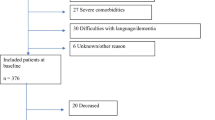Abstract
Aim
Whether smoking affects disease distribution, phenotype, and perioperative outcomes for Crohn’s disease (CD) patients undergoing surgery is not well characterized. The aim of this study is to evaluate the impact of smoking on disease phenotype and postoperative outcomes for CD patients undergoing surgery
Methods
Prospectively collected data of CD patients undergoing colorectal resection were evaluated. CD patients who were current smokers (CS) were compared to nonsmokers (NS) and ex-smokers (ES) for disease phenotype, anatomic site involved, procedures performed, postoperative outcomes, and quality of life using the Cleveland Global Quality of Life instrument (CGQL).
Results
Of 691 patients with a diagnosis of CD requiring surgery 314 were classified as CS, 330 as NS, and 47 as ES. CS and ES in comparison to NS were significantly older at diagnosis of Crohn’s disease (mean, 29.3 vs. 29.2 vs. 26.3 years) (P = 0.001) and older at the time of primary surgery (mean, 42.9 vs. 48.4 vs. 39 years) (P = 0.001) with a greater frequency of diabetes. In all groups requiring surgery, there was a significant change in disease phenotype from the time of diagnosis to surgical intervention. The predominant phenotype at diagnosis was inflammatory which changed to stricturing and penetrating as the dominant phenotypes at time of surgery. All groups had a significant improvement in CGQL scores post-surgery with the greatest benefit observed in NS. Postoperative complications and 30-day readmission rates were similar between all groups.
Conclusions
The findings of this study show that in patients with CD, disease phenotype changes over time. This occurs independent of smoking. Smoking does not appear to predispose to complications for CD patients undergoing surgery. CS and ES have a persistently reduced quality of life in comparison to NS post-surgery.

Similar content being viewed by others
References
Rubin DT, Hanauer SB (2000) Smoking and inflammatory bowel disease. Eur J Gastroenterol Hepatol 12:855–862
Langholz E (2010) Current trends in inflammatory bowel disease. Therap Adv Gastroenterol 3:77–86
Thomas GA, Rhodes J, Green JT, Richardson C (2000) Role of smoking in inflammatory bowel disease: implications for therapy. Postgrad Med J 76:273–279
Picco MF, Bayless TM (2003) Tobacco consumption and disease duration are associated with fistulizing and stricturing behaviors in the first 8 years of Crohn’s disease. Am J Gastroenterol 98:363–368
Kane SV, Flicker M, Katz-Nelson F (2005) Tobacco use is associated with accelerated clinical recurrence of Crohn’s disease after surgically induced remission. J Clin Gastroenterol 39:32–35
Moller AM, Villebro N, Pedersen T, Tonnesen H (2002) Effect of preoperative smoking intervention on postoperative complications: a randomised clinical trial. Lancet 359:114–117
Yamamoto T (2005) Factors affecting recurrence after surgery for Crohn’s disease. World J Gastroenterol 11:3971–3979
Delgado-Rodriguez M, Medina-Cuadros M, Martinez-Gallego G et al (2003) A prospective study of tobacco smoking as a predictor of complications in general surgery. Infect Control Hosp Epidemiol 24:37–43
Finan KR, Vick CC, Kiefe CI, Neumayer L, Hawn MT (2005) Predictors of wound infection in ventral hernia repair. Am J Surg 190:676–681
Kiran RP, Delaney CP, Senagore AJ et al (2003) Prospective assessment of Cleveland Global Quality of Life and disease activity in Crohn’s disease. Am J Gastroenterol 98:1783–1789
Fazio VW, O’Riordain MG, Lavery IC et al (1999) Long-term functional outcome and quality of life after stapled restorative proctocolectomy. Ann Surg 230:575–586
Sorensen LT, Karlsmark T, Gottrup F (2003) Abstinence from smoking reduces incisional wound infection: a randomized controlled trial. Ann Surg 238:1–5
Moller A, Tonnesen H (2006) Risk reduction: perioperative smoking intervention. Best Pract Res Clin Anaesthesiol 20:237–248
Theadom A, Cropley M (2006) Effects of preoperative smoking cessation on the incidence and risk of intraoperative and postoperative complications in adult smokers: a systematic review. Tob Control 15:352–358
Avidan B, Sakhnini E, Lahat A et al (2005) Risk factors regarding the need for a second operation in patients with Crohn’s disease. Digestion 72:248–253
Lindeberg E, Jarnerot G, Huitfeldt (1992) Smoking in Crohn’s disease:effect on localization and clinical course. Gut 33:779–782
Yamamoto T, Kneighley RB (1999) The association of cigarette smoking with a high risk of recurrence after ileocolic resection for ileocecal Crohn’s disease. Surg Today 29:579–580
Ford AC, Sandbom WJ, Khan KJ et al (2011) Efficacy of biological therapies in inflammatory bowel disease: systematic review and meta-analysis. Am J Gastroenterol 106:644–659
Canavan C, Abrams KR, Mayberry JF (2007) Meta-analysis: mortality in Crohn’s disease. Aliment Pharmacol Ther 25:861–870
Lakatos PL, Czegledi Z, Szamosi T et al (2009) Perianal disease, small bowel disease, smoking, prior steroid or azathioprine/biological therapy are predictors of disease change in patients with Crohn’s disease. World J Gastroenterol 15:3505–3510
Louis E, Collard A, Oger AF et al (2001) Behaviour of Crohn’s disease according to the Vienna classification: changing pattern over the course of the disease. Gut 49:777–782
Chow DK, Leong RW, Lai LH et al (2008) Changes in Crohn’s disease phenotype over time in the Chinese population: validation of the Montreal classification system. Inflamm Bowel Dis 14:536–541
Hongyan C, Alexander L, Bowcock A et al (2011) Influence of Crohn’s disease risk alleles and smoking on disease location. Dis Colon Rectum 54:1020–1025
Tamas S, Janos B, Lakatos L et al (2010) Early azathioprine/biological therapy is associated with decreased risk for first surgery and delays to time to surgery but not reoperation in both smokers and nonsmokers with Crohn’s disease, while smoking decreases the risk of colectomy in ulcerative colitis. Eur J Gastroenterol Hepatol 22:872–879
Sunyoung P, Do-Hoon L, Jae-Gahb P, Young T (2010) A sensitive enzyme immunoassay for measuring cotinine in passive smokers. Clinica Chimica Acta 411:1238–1242
Acknowledgments
The authors thank Jeffrey P. Hammell for help with the study design and statistics.
Conflicts of interest
None.
Author information
Authors and Affiliations
Corresponding author
Additional information
Poster presentation at American Society of Colon and Rectal Surgeons Tripartite Meeting, 7–12 June, 2008, Boston, MA
Rights and permissions
About this article
Cite this article
Joyce, M.R., Hannaway, C.D., Strong, S.A. et al. Impact of smoking on disease phenotype and postoperative outcomes for Crohn’s disease patients undergoing surgery. Langenbecks Arch Surg 398, 39–45 (2013). https://doi.org/10.1007/s00423-011-0865-9
Received:
Accepted:
Published:
Issue Date:
DOI: https://doi.org/10.1007/s00423-011-0865-9



